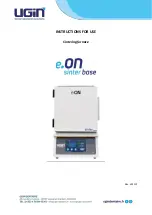
Page 43
31-5000729 Rev. 0
4.
Move gas valve switch to OFF.
5.
Replace the access panel.
Failure To Operate
If the unit fails to operate, check the following:
1.
Is the thermostat calling for heat?
2.
Are access panels securely in place?
3.
Is the main disconnect switch closed?
4.
Is there a blown fuse or tripped breaker?
5.
Is the filter dirty or plugged? Dirty or plugged filters will
cause the limit control to shut the unit off.
6.
Is gas turned on at the meter?
7.
Is the manual main shut-off valve open?
8.
Is the internal manual shut-off valve open?
9.
Is the unit ignition system in lockout? If the unit locks out
again, inspect the unit for blockages.
Heating System Service Checks
C.S.A. Certification
All units are C.S.A. design certified without modifications.
Refer to the NF96DS Operation and Installation Instruction.
Gas Piping
If a flexible gas connector is required or allowed by
the authority that has jurisdiction, black iron pipe shall
be installed at the gas valve and extend outside the
furnace cabinet. The flexible connector can then be
added between the black iron pipe and the gas supply
line.
CAUTION
Do not over torque (800 in-lbs) or under torque (350
in-lbs) when attaching the gas piping to the gas valve.
WARNING
Gas supply piping should not allow more than 0.5” W.C. drop
in pressure between gas meter and unit. Supply gas pipe
must not be smaller than unit gas connection.
Compounds used on gas piping threaded joints should be
resistant to action of liquefied petroleum gases.
Testing Gas Piping
In case emergency shutdown is required, turn off the
main shut-off valve and disconnect the main power to
unit. These controls should be properly labeled by the
installer.
IMPORTANT
When pressure testing gas lines, the gas valve must be
disconnected and isolated. Gas valves can be damaged if
subjected to more than 0.5 psig (14” W.C.). See Figure 50.
Figure 50.
MANUAL MAIN SHUT-OFF
VALVE WILL NOT HOLD
NORMAL TEST PRESSURE
CAP
FURNACE
ISOLATE
GAS VALVE
1/8” N.P.T. PLUGGED TAP
When checking piping connections for gas leaks, use
preferred means. Kitchen detergents can cause harmful
corrosion on various metals used in gas piping. Use of a
specialty Gas Leak Detector is strongly recommended.
Do not use matches, candles, flame or any other source
of ignition to check for gas leaks.
WARNING
Testing Gas Supply Pressure
When testing supply gas pressure, use the 1/8” N.P.T.
plugged tap or pressure post located on the gas valve to
facilitate test gauge connection. See Figure 49. Check gas
line pressure with unit firing at maximum rate. Low pressure
may result in erratic operation or underfire. High pressure
can result in permanent damage to gas valve or overfire.
On multiple unit installations, each unit should be checked
separately, with and without units operating. Supply pressure
must fall within range listed in Table 14.
Check Manifold Pressure
After line pressure has been checked and adjusted, check
manifold pressure. Move pressure gauge to outlet pressure
tap located on unit gas valve (GV1).
Checks of manifold pressure are made as verification of
proper regulator adjustment.














































